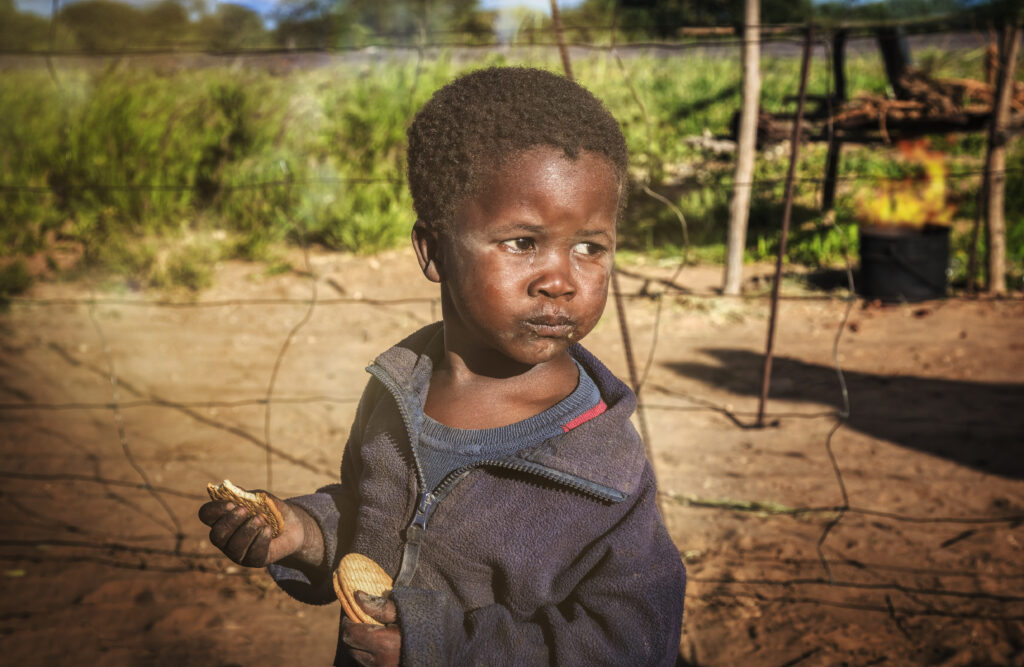A Call to Action
Addressing Malnutrition Among Colombian Children

by Delia Visbal
Malnutrition remains a pressing issue affecting children worldwide, and Colombia is no exception. Despite efforts to combat this problem, many Colombian children continue to suffer from inadequate nutrition, posing serious threats to their health and well-being.
According to the National Administrative Department of Statistics (DANE), there are approximately 560,000 children suffering from chronic malnutrition in Colombia. In addition, the National Institute of Health (INS) reported that in 2022 there were 21,337 cases of acute malnutrition in children under five years of age, reflecting the seriousness of the situation in the country (UNICEF) (Public Reason) (Semana). Between 2022 and 2023, the malnutrition rate in Colombia increased significantly. The National Institute of Health (INS) reported an increase in cases of acute malnutrition in children under five years of age, registering 8,545 children diagnosed in 2023 (UNICEF) (Razón Pública) (Semana).
Between 2022 and 2023, the malnutrition rate in Colombia increased significantly. The National Institute of Health (INS) reported an increase in cases of acute malnutrition in children under five years of age, registering 8,545 children diagnosed in 2023. (Razón Pública) (RTVC Noticias).
In this article, we delve into the definition of malnutrition, its root causes and consequences, and explore potential solutions, including the role of organizations like NEACOL in fighting it.
What is malnutrition?
The World Health Organization (WHO) is the primary international organization that defines and addresses malnutrition in children. The WHO provides guidelines, definitions, and standards for assessing and treating malnutrition, including criteria for conditions such as wasting, stunting, and underweight. They also collaborate with other organizations like UNICEF (United Nations International Children’s Emergency Fund) to implement programs and policies aimed at combating child malnutrition globally.
According to The World Health Organization (WHO), malnutrition refers to deficiencies, excesses, or imbalances in a person’s intake of energy and/or nutrients. In the context of children, malnutrition includes:
Undernutrition: This can further be categorized into:
Wasting: Low weight-for-height, reflecting acute malnutrition.
Stunting: Low height-for-age, reflecting chronic malnutrition.
Underweight: Low weight-for-age, which can be a composite measure reflecting both acute and chronic malnutrition.
Micronutrient deficiencies: Lack of essential vitamins and minerals.
Overnutrition: This includes overweight and obesity, resulting from excessive intake of energy, often coupled with a lack of physical activity.
The WHO uses specific growth standards and reference data to assess and classify the nutritional status of children, focusing on these key indicators to monitor and address malnutrition.
What are the roots of malnutrition in Colombian children?
The causes of malnutrition in Colombian children are multifaceted and can be attributed to a combination of socioeconomic, environmental, and health-related factors. Some of the primary causes include:
Poverty: Economic disparities play a significant role in Colombia, with poverty-stricken families struggling to afford nutritious food, healthcare and education. According to data from the World Bank, approximately 27% of Colombia’s population lives below the national poverty line (below US$2.15 per day per capita). This economic hardship is a significant driver of malnutrition.
Food Insecurity: Limited access to sufficient, safe, and nutritious food contributes to malnutrition. Food insecurity and limited access to essential nutrients are often exacerbated by poverty, economic instability and displacement due to conflict.
Lack of education and Inadequate Dietary Intake. The majority of parents in households in need have very low education. In many cases, they haven’t even finished high school. Lack of education, particularly among mothers, can lead to poor feeding practices and a lack of knowledge about the availability of diverse foods and the importance of nutrition for child development. So parents or caretakers don’t know what exactly a child needs to be healthy. Thus, children may not receive a balanced diet that includes the necessary macronutrients and micronutrients for proper growth and development. They tend to eat a lot of carbs and not enough vegetables and fruit.
Healthcare Access: Most families in need in Colombia live in rural and marginalized areas of the country and in indigenous settlements where access to healthcare services is inadequate which can lead to untreated infections and diseases that exacerbate malnutrition. Poor maternal health and inadequate prenatal care can also affect a child’s nutritional status from birth.
Lack of sanitation and clean drinking water: Poor hygiene practices and lack of clean water contribute to the spread of diseases that can impair nutrient absorption and weaken immune systems, making children more susceptible to malnutrition. It’s worth noting that there are still many towns in Colombia without a reliable water system and street plumbing, exacerbating sanitation issues and increasing the risk of waterborne illnesses such as diarrhea, which can impair nutrient absorption and increase the risk of malnutrition.
Conflict and Displacement: Ongoing internal conflicts and violence have displaced many families in Colombia, disrupting their livelihoods and access to food and healthcare services, thereby increasing the risk of malnutrition among children.
Other causes of malnutrition are:
Agricultural Practices: Inadequate agricultural practices and dependency on certain crops can limit the availability and diversity of food, affecting the nutritional quality of diets.
Climate Change: Climate-related events such as floods, droughts, and extreme weather conditions can affect food production and availability, leading to food shortages and malnutrition.The Colombian Health Ministry warned of the potential exacerbation of childhood health situations with the climate phenomenon of El Niño: increased droughts and effects on the agricultural activity for food production.

Why is it important to fight malnutrition in children?
The consequences of malnutrition in children’s lives are profound and far-reaching. Fighting malnutrition in children is crucial for several reasons, each highlighting the profound impact that proper nutrition has on individual health, community well-being, and broader societal development:
Physical Health and Growth: Adequate nutrition is essential for normal physical growth and development. Malnutrition can lead to stunted growth, underweight, and wasting, which can have long-term effects on a child’s physical health and development.
Cognitive Development: Proper nutrition, especially in the early years, is vital for brain development. Malnutrition can stun physical growth and impair cognitive abilities, affecting learning, concentration, and academic performance hindering children’s ability to thrive and reach their full potential which can limit future opportunities.
Immune System Function: Good nutrition strengthens the immune system, reducing the risk and severity of infections and illnesses. Malnourished children are more susceptible to diseases, which can be more severe and harder to recover from, often leading to a vicious cycle of illness and malnutrition.
Survival Rates: Severe malnutrition significantly increases the risk of mortality in children. Undernourished children are more vulnerable to life-threatening conditions and complications from common illnesses.
Long-term Health: Childhood malnutrition can lead to chronic health issues in adulthood, including increased susceptibility to non-communicable diseases such as diabetes, hypertension, and heart disease. It also can result in lifelong physical and cognitive impairments.
Economic Development: Healthy children are more likely to grow into productive adults. Malnutrition can hinder educational achievement and workforce productivity, impacting economic growth and development. Investing in child nutrition can result in a more educated and capable workforce, boosting economic prosperity.
Social Equity: Addressing malnutrition is crucial for social justice and equity. Vulnerable and marginalized communities are often the most affected by malnutrition. Ensuring all children have access to adequate nutrition helps bridge social and economic gaps, promoting a more equitable society. Malnutrition perpetuates the cycle of poverty, as stunted children are less likely to perform well in school and secure gainful employment in the future. This perpetuates the intergenerational transmission of poverty, trapping families in a cycle of deprivation and limited opportunities.
Intergenerational Impact: Malnutrition in children can have lasting effects that span generations. Malnourished girls are more likely to become malnourished mothers, perpetuating a cycle of poor health and nutrition in their offspring. Breaking this cycle is vital for the health and well-being of future generations.
Achievement of Global Goals: Combating child malnutrition is essential for achieving several Sustainable Development Goals (SDGs), particularly those related to health (SDG 3), hunger (SDG 2), education (SDG 4), and poverty (SDG 1). Addressing malnutrition is integral to broader global development and humanitarian efforts.
Fighting malnutrition in children is not only a moral imperative but also a strategic investment in the future health, stability, and prosperity of societies worldwide.
Addressing the Issue:
Addressing malnutrition requires a comprehensive approach that addresses its underlying causes and provides holistic solutions. Firstly, increasing access to nutritious food through targeted interventions such as food assistance programs and agricultural development initiatives is essential. These efforts should prioritize Colombia’s marginalized communities and vulnerable populations most affected by food insecurity.
Additionally, improving access to healthcare services and promoting proper nutrition education are crucial steps in preventing and treating malnutrition. Investing in maternal and child health programs, including prenatal care and early childhood nutrition interventions, can have a significant impact on reducing malnutrition rates and improving child outcomes.

NEACOL’s Role in fighting malnutrition in Colombia:
NEACOL (New England Association for Colombian Children) is a nonprofit organization based in Massachusetts, composed of Colombians and friends of Colombia committed to volunteering and collaborating to support social initiatives for the benefit of Colombian children. Our goals are to generate innovative ideas, raise awareness, and channel resources to provide a better quality of life for Colombian children in need. The three areas of focus for NEACOL are education, health and nutrition.
NEACOL provides access to nutritious food, addresses food insecurity, and promotes healthy eating. This helps improve children’s overall health, reduces the risk of chronic diseases, helps children develop lifelong healthy habits and reduces the risk of diet-related health problems.
By focusing on holistic interventions that address the multifaceted nature of malnutrition, organizations like NEACOL play a vital role in improving the health and well-being of Colombian children and fostering brighter futures for generations to come.
NEACOL’s Call for Proposals 2024/2025:
NEACOL opens every year a call for proposals for organizations that support programs that work on improving the living conditions of Colombian children from 0-5 years old experiencing malnutrition. The ones selected will receive financial resources from NEACOL to continue executing their programs. Visit the NEACOL 2024 Call for Proposals page to learn more.
In conclusion, several infrastructural deficiencies in Colombia underscore the urgent need for comprehensive interventions to address malnutrition and improve living conditions of children in marginalized and vulnerable populations.
Addressing malnutrition among Colombian children requires concerted efforts from governments, civil society organizations, and the international community to tackle the roots of malnutrition and improve access to nutritious food, healthcare, clean water, and sanitation, as well as promoting education and sustainable agricultural practices. Programs and policies by the Colombian government, along with support from international organizations like NEACOL aim to tackle these underlying causes and improve the nutritional status of children.
By addressing the root causes of malnutrition we can create a brighter future where every child has the opportunity to thrive. Organizations like NEACOL exemplify the power of collective action in combating malnutrition and building healthier, more prosperous communities.
Help us support Colombian children in need. Your contribution will help us continue to work for this cause. Click here to donate.
Thank you for helping us fight Colombian children’s malnutrition.
